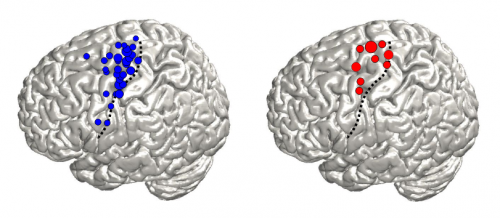Researchers use signals from natural movements to identify brain regions

Whether we run to catch a bus or reach for a pen: Activities that involve the use of muscles are related to very specific areas in the brain. Traditionally, their exact location has only been determined through electrical stimulation or unnatural, experimental tasks. A team of scientists in Freiburg has now succeeded for the first time in mapping the brain's surface using measurements of everyday movements.
Attributing abilities to specific brain regions and identifying pathological areas is especially important in the treatment of epilepsy patients, as severe cases require removal of neural tissue. Until now, such "mapping" involved stimulating individual regions of the brain's surface with electric currents and observing the reaction or sensation. Alternatively, patients were asked to perform the same movements again and again until the physicians isolated the corresponding patterns in brain activity. However, these methods required for the patient to cooperate and to provide detailed answers to the physicians' questions. This is a prerequisite that small children or patients with impaired mental abilities can hardly meet, and hence there is a need for other strategies
Scientists from the group of Dr. Tonio Ball at the Cluster of Excellence "BrainLinks-BrainTools" and the Bernstein Center Freiburg report in the current issue of NeuroImage that the brain's natural activity during everyday movements can also be used to reliably identify the regions responsible for arm and leg movements.
The researchers examined data from epilepsy patients who had electrodes implanted under their skull prior to surgery. Using video recordings, the team captured the spontaneous movements of their patients, searching for concurrent signals of a certain frequency in the data gathered on the surface of the brain. They succeeded in creating a map of the brain's surface for arm and leg movements that is as accurate as those created through established experimental methods.
A big hope for the team of researchers is also to gain new insights into the control of movements in the brain, as their method allows them to explore all manner of behaviors and is no longer limited to experimental conditions. Last but not least, the scientists explain that this new method of analyzing signals from the brain will contribute to the development of brain-machine interfaces that are suitable for daily use.
More information: Ruescher, J. et al. (2013) Somatotopic mapping of natural upper- and lower-extremity movements and speech production with high gamma electrocorticography. NeuroImage 81, 164-177.















